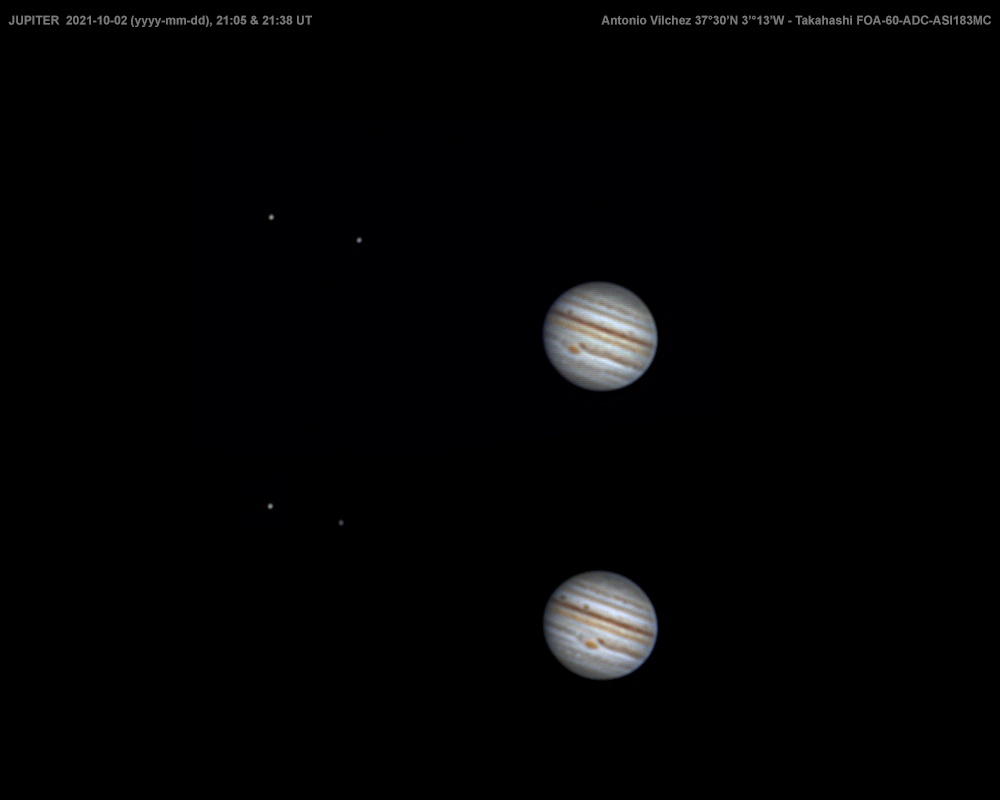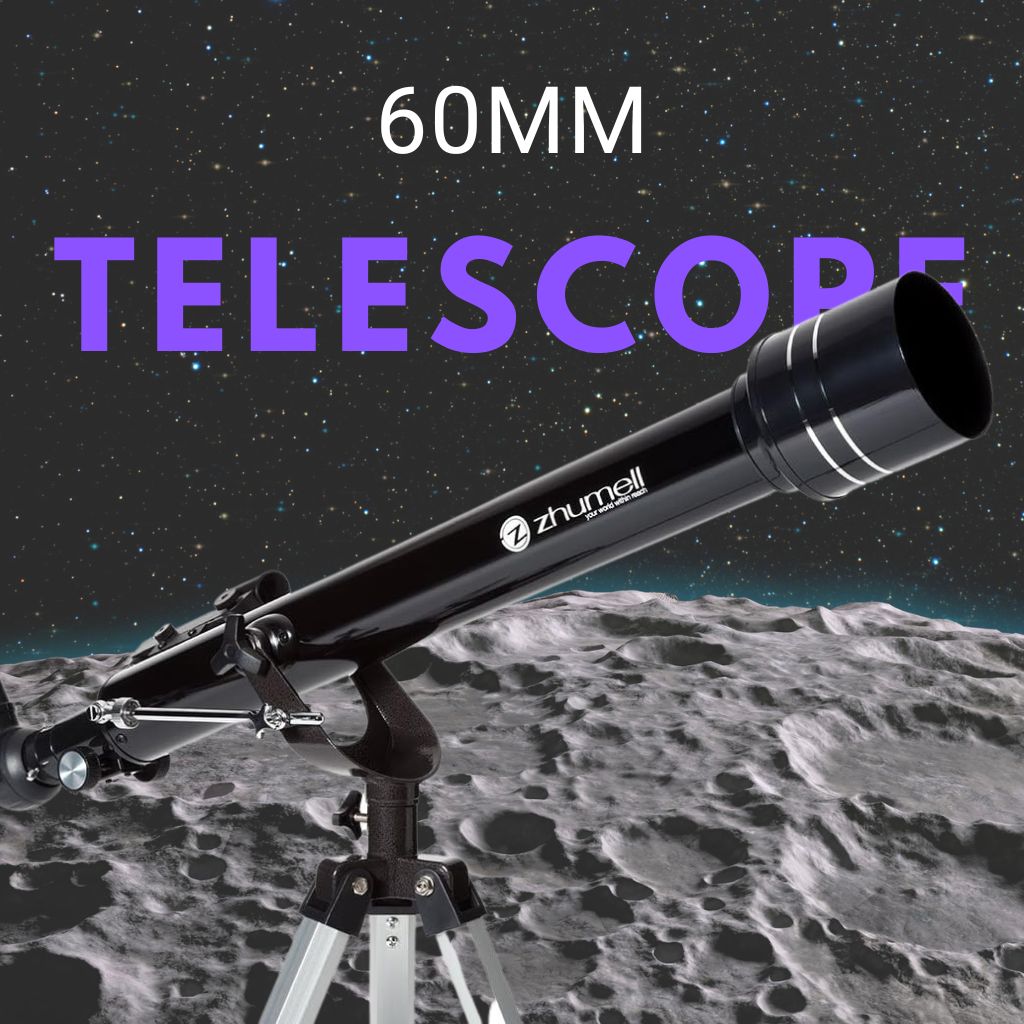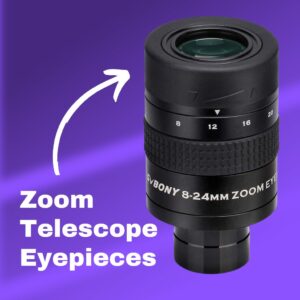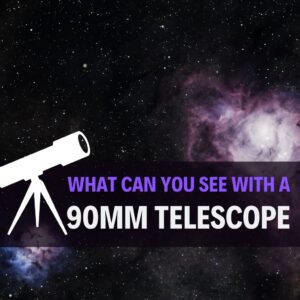This site contains affiliate links to products. I may receive a commission for purchases made through these links.
A 60mm telescope can reveal views of the moon, planets, and some brighter deep-sky objects. It is perfect for beginners, amateur astronomers, and general stargazers.
As a curious stargazer or a budding astronomer, you may find yourself wondering about the capabilities of a 60mm telescope. Perhaps you’ve heard that larger telescopes offer superior views, but don’t dismiss the potential of a smaller instrument just yet.
A 60mm telescope can provide you with captivating observations of a variety of celestial objects.
This article will unravel what a 60mm telescope can offer, its advantages and limitations, and how to enhance your stargazing experience with the right accessories.
What objects can I see with a 60mm telescope?
Here are the objects you can see with a 60mm telescope.
Solar system objects
A 60mm telescope can reveal the following objects in our solar system:
The Moon
A 60mm telescope can provide clear views of the Moon’s surface, highlighting its fascinating craters and mountain ranges.
Planets

You can also observe major planets like Jupiter, Mars, Saturn, and Venus. Depending on viewing conditions, features such as Jupiter’s cloud bands, Saturn’s rings, and Mars’ ice caps could be discerned.
Deep sky objects
With the right conditions and location (dark skies with minimal light pollution), a 60mm telescope can reveal several deep sky objects.
Here are a few you might spot:
Star clusters
Star clusters, like the Pleiades and the Double Cluster in Perseus, are a delight to view through a 60mm telescope.
Nebulae
A few bright nebulae, such as the Orion Nebula and Ring Nebula, are within reach of this aperture size.
Can you observe galaxies with a 60mm telescope?
The Andromeda Galaxy and the bright cores of a few other galaxies can be viewed, although they will appear as faint smudges due to the telescope’s limited light-gathering capacity.
Is a 60mm aperture good for a telescope?
A 60mm aperture is good for a telescope, especially for beginners and for general stargazing. This size offers a balance between portability, ease of use, and viewing capability.
A 60mm telescope with good optical quality can provide stunning views that will enthrall both beginner and seasoned astronomers alike.
You may also like: What Is a Good Aperture for a Telescope?
Is a 60mm telescope suitable for beginners?
A 60mm telescope is a fantastic entry point for beginners. It’s portable, affordable, and user-friendly. Its viewing capacity is suitable for learning the basics of stargazing, offering a rewarding experience without the complications of a larger scope.
Is a 60mm telescope suitable for astrophotography?
A 60mm telescope can be used for basic astrophotography, capturing images of the Moon and the planets. However, due to its smaller aperture and limited light-gathering ability, it may not be the best choice for photographing fainter objects or achieving highly detailed images.
What magnification is a 60mm telescope?
A 60mm telescope typically comes with eyepieces that provide magnifications ranging from 20x to 100x. However, the highest practical limit for useful magnification is often said to be 50x to 60x per inch of aperture.
For a 60mm telescope (approximately 2.4 inches), this equates to about 120x to 144x magnification.
Advantages of a 60mm telescope
Below are some of the advantages of a 60mm telescope:
Portability
One significant advantage of a 60mm telescope is its portability. Due to its compact size, it’s easy to transport and set up, making it ideal for impromptu stargazing sessions or trips to dark-sky locations.
Affordability
Generally, 60mm telescopes are affordable. They provide a cost-effective entry into the world of astronomy, perfect for beginners not ready to invest in larger, more expensive scopes.
Ease of use
A 60mm telescope is relatively simple to operate, making it perfect for beginners. Learning to navigate the night sky is less daunting with a smaller, more manageable scope.
Limitations of a 60mm telescope
Here are some of the cons of a 60mm telescope:
Limited light-gathering ability
A 60mm telescope’s smaller aperture collects less light compared to larger scopes. This limitation makes fainter objects, such as galaxies and nebulae, difficult to observe.
Lower resolving power
The resolving power, or the ability to see detail, is directly related to the aperture size. A 60mm telescope, having a small aperture, may not provide the detailed views of lunar and planetary surfaces that larger telescopes can.
Features and components of a 60mm telescope
Let’s explore some of the common features and components of 60mm telescopes:
Objective lens
The 60mm objective lens, or aperture, is the light-gathering ‘eye’ of the telescope. A 60mm telescope has an objective lens with a 60mm diameter.
Focal length
Focal length plays a crucial role in the capabilities of a 60mm telescope. It refers to the distance between the objective lens of the telescope and the point where the incoming light converges into a focused image.
In simpler terms, the focal length determines the magnification power of the telescope. With a specific focal length, the 60mm telescope can provide a range of magnification options for observing celestial objects with varying levels of detail and zoom.
Optical tube
The optical tube of a 60mm telescope serves as the protective housing for the objective lens and the eyepiece. Its primary function is to maintain a dark and unobstructed path for the incoming light, thereby ensuring clear and bright images of the observed objects.
With its precise engineering, the optical tube optimizes the transmission of light, allowing the 60mm telescope to deliver impressive visual experiences of celestial wonders.
How do I choose the right 60mm telescope?
When choosing the right 60mm telescope, several critical factors must be considered. Each contributes to your overall experience.
Let’s break down these considerations:
Budget
Consider how much you’re willing to spend. Remember, having a simpler, good-quality telescope is better than a feature-packed model with substandard optics.
Observing interests
Think about what you’re most interested in observing. For planetary and lunar viewing, nearly any good-quality telescope will do. However, if you’re interested in observing deep-sky objects, you might opt for a larger aperture.
Portability
If you plan on taking your telescope to dark-sky sites away from city light pollution, look for a model that’s easy to transport and set up.
Mount type
Consider the type of mount included. Altazimuth mounts are generally easier for beginners to use, but equatorial mounts allow for easier tracking of celestial objects as they move across the sky.
Included accessories
Look for a telescope that includes at least one or two eyepieces and possibly a Barlow lens to increase magnification options.
Best 60mm telescopes
If you are a beginner or an astronomy enthusiast, the following telescopes offer a fantastic entry point into the world of astronomy, allowing you to embark on a captivating journey of discovery:
Celestron PowerSeeker 60EQ Telescope
The Celestron PowerSeeker 60EQ is a top-of-the-line entry-level telescope. It’s a refractor-style telescope with a 60mm aperture, offering bright, clear images of celestial objects.
This model comes with two eyepieces (20mm and 4mm), delivering magnification levels of 35x and 175x, and a 3x Barlow lens to triple the magnifying power of each eyepiece.
The PowerSeeker 60EQ also features an equatorial mount for smooth movement, an aluminum tripod for stability, and the Starry Night Astronomy Software for an interactive sky simulation.
Its “The Sky” Level 1 planetarium software has a 10,000-object database to help you locate and identify celestial objects.
Zhumell 60mm AZ Refractor Telescope
The Zhumell 60mm AZ Refractor Telescope is a fantastic option for those seeking a compact and user-friendly telescope. With its 60mm objective lens, this refractor telescope captures ample light to provide clear and detailed views of the Moon, planets, star clusters, and even some brighter deep-sky objects.
The alt-azimuth mount allows for easy and intuitive movement, making it ideal for beginners and casual observers. The telescope comes with two eyepieces of different focal lengths, offering versatility in magnification options.
Accessories to enhance the viewing experience with a 60mm telescope
Telescope accessories can significantly enhance your stargazing experience. They can boost the functionality of your telescope or make observation more comfortable.
Here are some accessories worth considering:
Eyepieces
Eyepieces play a crucial role in viewing celestial objects by magnifying the light gathered by your telescope. Investing in a good set of eyepieces of different focal lengths can dramatically increase the versatility of your 60mm telescope.
Here are some recommended options:
- Celestron – Omni Series 1-1/4″ Eyepiece Set: A versatile set of four high-quality eyepieces that offer a wide range of magnifications. These eyepieces are multi-coated for bright, sharp images.
- Explore Scientific is the Explore Scientific 82° Series: These eyepieces provide a wide apparent field of view and are known for their excellent clarity and sharpness. They are available in various focal lengths, allowing you to choose the magnification that suits your observing needs.
Barlow lens
A Barlow lens is a handy accessory that effectively doubles or triples the magnification of your existing eyepieces, offering a wider range of magnifications without the need for multiple eyepieces.
Here are some recommended options:
- Celestron – Omni 2x Barlow Lens: This high-quality, 2x Barlow lens doubles the magnification of your eyepieces, effectively doubling your eyepiece collection.
- SVBONY Barlow Lens 2X 1.25 inch: This is a compact and versatile accessory that can effectively double the magnification of your telescope’s eyepieces.
Star charts and apps
Star charts and astronomy apps can help you learn your way around the night sky and identify what you’re looking at.
Here are some recommended options:
- National Geographic Backyard Guide to the Night Sky: This is a great guide for beginners, offering easy-to-understand information and charts to help you navigate the night sky.
- SkySafari – Astronomy App: A comprehensive astronomy app that offers detailed information about celestial objects, a night mode for use while observing, and interactive star charts that adjust to your location and the current date and time.
Telescope filters
Filters enhance the view of certain celestial objects. For example, a lunar filter reduces the moon’s brightness and brings out more detail.
Here are some options worth considering:
- Celestron – Moon Filter: This filter reduces the glare from the moon, improving contrast and bringing out more detail in the lunar landscape.
- Orion 1.25-Inch 13 Percent Transmission Moon Filter: Another excellent option for lunar observation, this filter blocks 87% of incoming light, enhancing your view of the moon.
To safely observe the Sun, you need a dedicated solar filter, such as Thousand Oaks Optical SolarLite Solar Filter. These filters block out all but a tiny fraction of incoming light to protect your eyes and your telescope.
FAQs about 60mm telescopes
Let’s address some of the most frequently asked questions regarding the use of a 60mm telescope.
What can you view with a 60x telescope?
With a 60x telescope, you can see various celestial objects such as the Moon’s craters, Jupiter’s largest moons, Saturn’s rings, and constellations.
Depending on your location and the clarity of the night sky, you may also see some bright nebulae and star clusters.
What are the main differences between a 60mm refractor telescope and a larger telescope?
The main differences between a 60mm refractor telescope and larger telescopes lie in the aperture size, magnification, and resolution. A larger telescope has a larger aperture, allowing more light, which means you can see fainter objects and more details.
However, a 60mm telescope is lighter, more portable, and often easier to handle, making it a great choice for beginners or for use as a ‘grab-and-go’ telescope.
What details can I see on the Moon with a 60mm refractor telescope?
With a 60mm refractor telescope, you can observe many details on the Moon. These include large craters, mountain ranges, and lunar seas (large, dark, flat areas).
With good seeing conditions, you may also be able to make out smaller features, such as medium-sized craters and their central peaks.
Which planets can I observe with a 60mm refractor telescope?
You can observe the Moon and the major planets of our solar system with a 60mm refractor telescope. Venus, Mars, Jupiter, and Saturn are often the most interesting to observe.
Jupiter’s cloud bands and four largest moons are visible, and you can see Saturn’s rings and its largest moon, Titan.
Can I observe deep sky objects with a 60mm refractor telescope?
Although a 60mm telescope’s capabilities are somewhat limited, observing some brighter deep-sky objects is still possible.
These might include the Orion Nebula, Andromeda Galaxy, and some of the brighter star clusters, such as the Pleiades and the Double Cluster in Perseus.
60mm or 70mm telescope, which is better?
Both 60mm and 70mm telescopes can serve beginners well. A 70mm telescope, having a larger aperture, can collect more light and thus provide brighter images and detail.
However, a 60mm telescope is often more compact and lightweight, making it easier to handle and transport. Ultimately, the “better” option will depend on your specific needs and circumstances.
Read also: What Can You See With a 70mm Telescope?
Takeaway: A 60mm telescope enables you to observe solar system objects and brighter deep sky objects
The 60mm telescope, despite its compact size, lets you glimpse many deep sky objects, including the Orion Nebula and the Andromeda Galaxy.
It can also help you discern double stars. Such a small aperture might seem limiting, but a 60mm telescope can surprise you with its capabilities, especially under clear, dark skies.
Objects that are faint to the naked eye, such as the Pleiades star cluster, come to life when viewed through a 60mm telescope.
With an appropriate focal ratio, a 60mm telescope can provide sharp, clear images, particularly of the Moon and planets.
This versatile tool opens up a wealth of astronomical objects for exploration, from our Moon’s cratered surface to the shimmering bands of Jupiter.
Its optical system, while compact, can efficiently gather and focus light to reveal celestial wonders.
Its portable nature makes it a perfect companion for those spontaneous stargazing nights or travel.
The 60mm telescope is an ideal starting point for any budding astronomer. But remember, the best telescope for you is one that you will use often.
So consider factors such as budget, portability, and ease of use before making a choice.
Don’t forget to subscribe to our newsletter where you’ll find the latest cosmic discoveries, expert stargazing tips, and exclusive subscriber deals. Embark on your cosmic journey if you haven’t already!
You may also like:
- What Can You See With an 80mm Refractor?
- What Can You See with a 90mm Telescope?
- What Can You See With a 100mm Refractor Telescope?
- What Can I See with a 114mm Telescope?
- What Can You See with a 120mm Refractor?
- What Can I See with a 130mm Telescope? (Answered!)
- What Can I See With a 150mm Telescope?
- What Can You See Through Different Telescopes (explained!)







